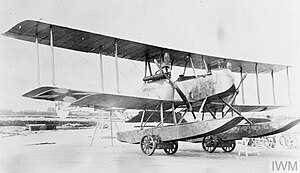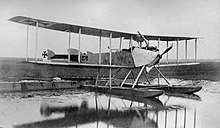Gotha WD.7
| WD.7 and WD.8 | |
|---|---|

| |
| A forward oblique view of a WD.7 on its beaching trolleys | |
| Role | torpedo-bomber trainer and reconnaissance |
| National origin | Germany |
| Manufacturer | Gotha |
| First flight | December 1915 |
| Primary user | Imperial German Navy |
| Number built | 8 x WD.7 ; 1 x WD.8 |
The Gotha WD.7 (Wasser Doppeldecker - "Water Biplane") was a reconnaissance floatplane developed in the German Empire during World War I.
Development
After the submarine SM U-9 sank three British armored cruisers on 22 September 1914 shortly after the war began, the German Imperial Naval Office (Reichsmarine-Amt) decided to try mounting torpedoes on aircraft as they were far easier and faster to build than submarines. Early trials with land-based aircraft were unsuccessful because of the great weight of the torpedo (645 kilograms (1,422 lb)) was more than existing aircraft could easily lift and the danger of trying to fly from an uneven grass airstrip with such a large weight of explosives. At the beginning of 1915 the Naval Office ordered the development of seaplanes capable of carrying torpedoes and the Seaplane Experimental Command (Seeflugzeug-Versuchs-Kommando (SVK)) issued requirements for these aircraft. They had to be twin-engine airplanes armed with a machine gun for self-defense and with a crew of two or three men: a pilot and observer for torpedo missions and a pilot, bombardier and gunner for bombing missions.[1]

After the pusher WD.3 was not accepted by the Imperial German Navy, Gotha turned to a new layout that would keep the aircraft's nose free for forward-firing weapons. The WD.7 therefore, was a conventional biplane with twin engines mounted tractor-fashion on the leading edge of the lower wing. Eight examples were built for use as trainers for torpedo bombing. During 1917, two of these aircraft were used for testing a 37 mm (1.46 in) autocannon built by DWM.
The same airframe was used to create the WD.8 reconnaissance floatplane, substituting the twin wing-mounted engines with a single Maybach Mb.IVa in the nose.
Variants
- WD.7
- twin-engine torpedo bomber trainer floatplane, powered by two 120 hp (89 kW) Mercedes D.II.[2]
- WD.8
- single-engine reconnaissance floatplane, powered by a 240 hp (180 kW) Maybach Mb.IV.[2]
Specifications (WD.7)

Data from German Aircraft of the First World War[2]
General characteristics
- Crew: 3
- Length: 11.3 m (37 ft 1 in)
- WD.8: 11.2 m (37 ft)
- Wingspan: 16 m (52 ft 6 in)
- Height: 3.585 m (11 ft 9 in)
- Wing area: 55.5 m2 (597 sq ft)
- WD.8: 59 m2 (640 sq ft)
- Empty weight: 1,440 kg (3,175 lb)
- WD.8: 1,250 kg (2,760 lb)
- Gross weight: 1,970 kg (4,343 lb)
- WD.8: 1,770 kg (3,900 lb)
- Powerplant: 2 × Mercedes D.II 6-cylinder water-cooled in-line pistone engines, 89 kW (120 hp) each
Performance
- Maximum speed: 136 km/h (85 mph, 73 kn)
- WD.8: 130 km/h (81 mph; 70 kn)
- Service ceiling: 4,000 m (13,000 ft)
- WD.8: 4,500 m (14,800 ft)
Armament
- Guns: WD.8: 7.92 mm (0.312 in) Parabellum MG 14 machine gun in the rear cockpit
- Bombs: WD.7: 1 x training torpedo
References
Bibliography
- Gray, Peter & Thetford, Owen (1987) [1970]. German Aircraft of the First World War (2nd ed.). London: Putnam. ISBN 0-85177-809-7.
- Herris, Jack (2013). Gotha Aircraft of WWI: A Centennial Perspective on Great War Airplanes. Great War Aviation Centennial Series. Vol. 6. Charleston, South Carolina: Aeronaut Books. ISBN 978-1-935881-14-8.
- Metzmacher, Andreas (2021). Gotha Aircraft 1913–1954: From the London Bomber to the Flying Wing Jet Fighter. Brimscombe, Stroud: Fonthill. ISBN 978-1-78155-706-8.
- Schmeelke, Michael (2020). "Torpedo Los!": The German Imperial Torpedo-Flieger. n.p.: Aeronaut Books. ISBN 978-1-953201-17-1.
- Schmeelke, Michael (2018). Zeebrugge: Naval Air Station Flanders I 1914–1918. Reno, Nevada: Aeronaut Books. ISBN 978-1-935881-46-9.
